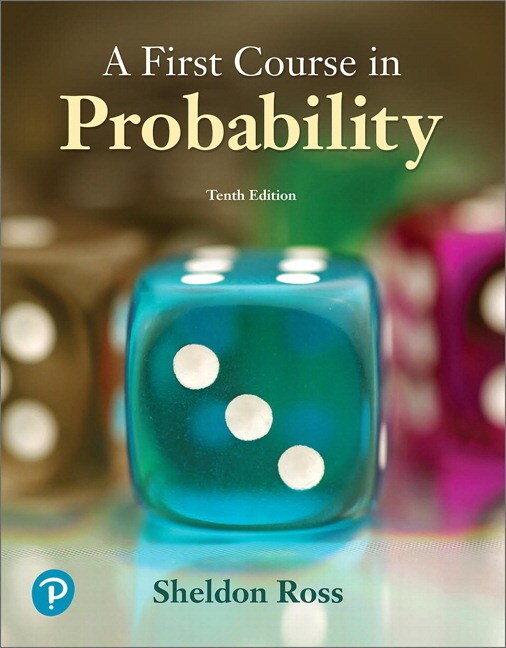
First Course in Probability, A, 10th edition
- Sheldon Ross

- Find it fast
Quickly navigate your eTextbook with search
- Stay organized
Access all your eTextbooks in one place
- Easily continue access
Keep learning with auto-renew
A First Course in Probability explores the mathematics and potential applications of probability theory. It is an elementary introduction to the theory of probability for upper-level and graduate students majoring in mathematics, statistics, engineering and the sciences. Through clear and intuitive explanations, it presents not only the mathematics of probability theory but also the many diverse possible applications of this subject using numerous examples. The 10th Edition includes many new and updated problems; new material on topics including the Pareto distribution, Poisson limit results, and the Lorenz curve; new examples such as computing NCAA basketball tournament win probabilities and the friendship paradox; revised and streamlined exposition for clarity and deeper understanding; and much more.
Published by Pearson (January 2nd 2023) - Copyright © 2024
ISBN-13: 9780138027889
Subject: Advanced Statistics
Category: Probability & Statistics
1. Combinatorial Analysis
- 1.1 Introduction
- 1.2 The Basic Principle of Counting
- 1.3 Permutations
- 1.4 Combinations
- 1.5 Multinomial Coefficients
- 1.6 The Number of Integer Solutions of Equations
- Summary
- Problems
- Theoretical Exercises
- Self-Test Problems and Exercises
2. Axioms of Probability
- 2.1 Introduction
- 2.2 Sample Space and Events
- 2.3 Axioms of Probability
- 2.4 Some Simple Propositions
- 2.5 Sample Spaces Having Equally Likely Outcomes
- 2.6 Probability as a Continuous Set Function
- 2.7 Probability as a Measure of Belief
- Summary
- Problems
- Theoretical Exercises
- Self-Test Problems and Exercises
3. Conditional Probability and Inference
- 3.1 Introduction
- 3.2 Conditional Probabilities
- 3.3 Bayes's Formula
- 3.4 Independent Events
- 3.5 P(·|F) Is a Probability
- Summary
- Problems
- Theoretical Exercises
- Self-Test Problems and Exercises
4. Random Variables
- 4.1 Random Variables
- 4.2 Discrete Random Variables
- 4.3 Expected Value
- 4.4 Expectation of a Function of a Random Variable
- 4.5 Variance
- 4.6 The Bernoulli and Binomial Random Variables
- 4.7 The Poisson Random Variable
- 4.8 Other Discrete Probability Distributions
- 4.9 Expected Value of Sums of Random Variables
- 4.10 Properties of the Cumulative Distribution Function
- Summary
- Problems
- Theoretical Exercises
- Self-Test Problems and Exercises
5. Continuous Random Variables
- 5.1 Introduction
- 5.2 Expectation and Variance of Continuous Random Variables
- 5.3 The Uniform Random Variable
- 5.4 Normal Random Variables
- 5.5 Exponential Random Variables
- 5.6 Other Continuous Distributions
- 5.7 The Distribution of a Function of a Random Variable
- Summary
- Problems
- Theoretical Exercises
- Self-Test Problems and Exercises
6. Jointly Distributed Random Variables
- 6.1 Joint Distribution Functions
- 6.2 Independent Random Variables
- 6.3 Sums of Independent Random Variables
- 6.4 Conditional Distributions: Discrete Case
- 6.5 Conditional Distributions: Continuous Case
- 6.6 Order Statistics
- 6.7 Joint Probability Distribution of Functions of Random Variables
- 6.8 Exchangeable Random Variables
- Summary
- Problems
- Theoretical Exercises
- Self-Test Problems and Exercises
7. Properties of Expectation
- 7.1 Introduction
- 7.2 Expectation of Sums of Random Variables
- 7.3 Moments of the Number of Events that Occur
- 7.4 Covariance, Variance of Sums, and Correlations
- 7.5 Conditional Expectation
- 7.6 Conditional Expectation and Prediction
- 7.7 Moment Generating Functions
- 7.8 Additional Properties of Normal Random Variables
- 7.9 General Definition of Expectation
- Summary
- Problems
- Theoretical Exercises
- Self-Test Problems and Exercises
8. Limit Theorems
- 8.1 Introduction
- 8.2 Chebyshev's Inequality and the Weak Law of Large Numbers
- 8.3 The Central Limit Theorem
- 8.4 The Strong Law of Large Numbers
- 8.5 Other Inequalities and a Poisson Limit Result
- 8.6 Bounding the Error Probability When Approximating a Sum of Independent Bernoulli Random Variables by a Poisson Random Variable
- 8.7 The Lorenz Curve
- Summary
- Problems
- Theoretical Exercises
- Self-Test Problems and Exercises
9. Additional Topics in Probability
- 9.1 The Poisson Process
- 9.2 Markov Chains
- 9.3 Surprise, Uncertainty, and Entropy
- 9.4 Coding Theory and Entropy
- Summary
- Problems and Theoretical Exercises
- Self-Test Problems and Exercises
10. Simulation
- 10.1 Introduction
- 10.2 General Techniques for Simulating Continuous Random Variables
- 10.3 Simulating from Discrete Distributions
- 10.4 Variance Reduction Techniques
- Summary
- Problems
- Self-Test Problems and Exercises